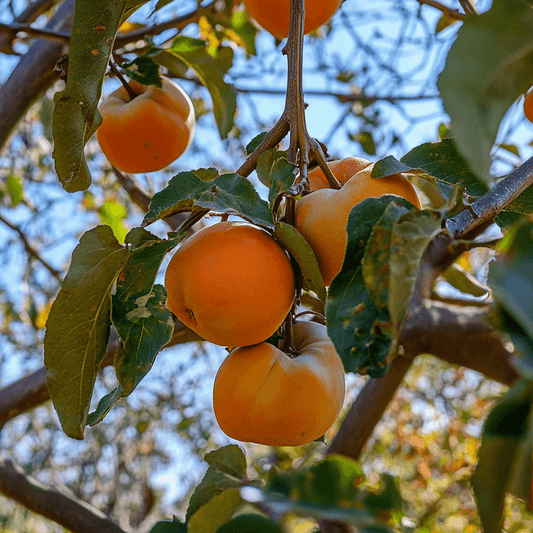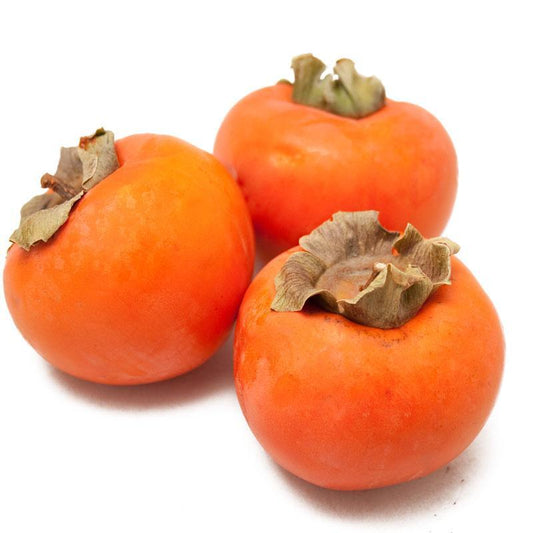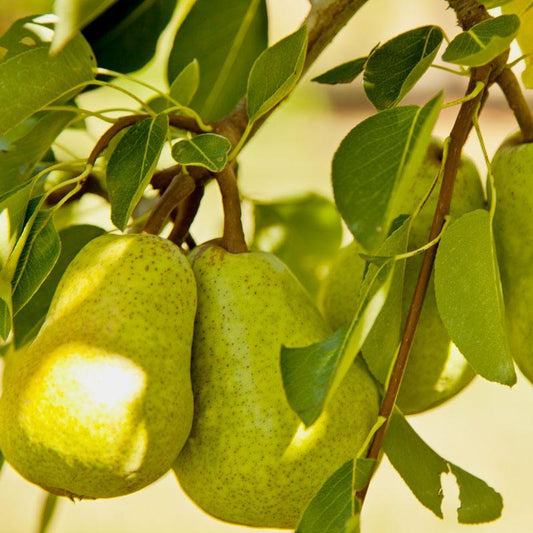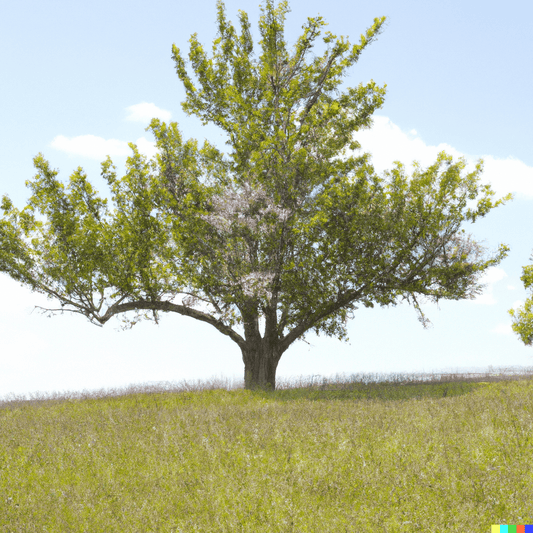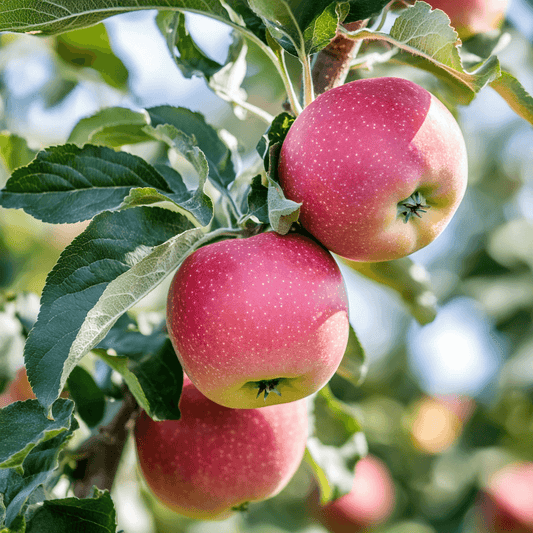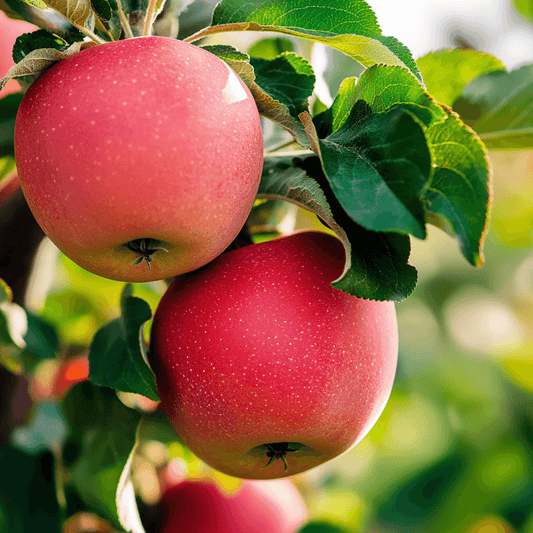The fundamental considerations and subtle nuances of growing and caring for trees are beyond the scope of this introduction to bare root tree care. Please see our selection of books on fruit tree care, as well as instructional videos and articles.
Receiving Your Trees

When you receive your bare root trees, they will be boxed securely with their roots wrapped in plastic, and their limbs and roots trimmed back (not fully pruned) to fit in the box.
First, inspect the bag and make sure that the media around the roots is moist. In the event that the media requires additional moisture, use a clean spray bottle to moisten it evenly. If you are not ready to plant your bare root tree upon arrival, see the “Heeling In” section below.
Make sure your tree’s roots do not freeze hard. Place them in a sheltered location like a garage if you expect a freeze before your trees are planted. It is essential that the young tree roots have plenty of time to become established before the tree begins its spring limb growth and bud break, so plant the tree while it is in deep dormancy.
Heeling In

When your bare root trees arrive, open the plastic bags immediately. It is best to plant your bare root tree right away, within a week of delivery. However if you cannot plant right away, you may “heel in” the trees to protect them and keep them alive (but still dormant) until you are able to plant them in their permanent spot.
Outdoors: To heel in bare root trees outside, pick a location that is shielded from wind. Dig a trench about twice as deep as the roots are long, with one side of the trench sloping at a 45° angle. Place the tree roots side down, so that the trunks are supported by the sloping side. Cover the roots with sawdust, dirt, wood shavings, but don’t use cedar or redwood shavings because they are toxic to the trees. Be sure to keep the root area moist, and gently tamp down to avoid air pockets. Periodically check the root area, keeping the soil moist.
Indoors: To heel in bare root trees indoors, whether due to snow or a frozen ground, choose a cool place like a root cellar, basement, or garage. It’s important to choose a place where the temperature stays between 38°F and 45°F. This is important so the tree roots won't freeze, and the tree doesn't break dormancy. Place the roots in a container and cover the roots with sawdust, dirt, wood shavings, but don’t use cedar or redwood shavings because they are toxic to the trees. Be sure to keep the root area moist. See our “Heeling in Bare Root Trees” video for more details.
If you don’t have a permanent location for your tree or are just not ready to plant it in the ground, you can plant it in a pot for a short-term solution. It is recommended to use at least a 10 gallon pot. Nut trees have a very large root system and should be planted in the ground (not recommended to plant in a pot).
Planting Location
Fruit trees are a long-term investment and caring for them properly, right from the start, will ensure years of enjoyment and productivity. Maintenance will be greatly minimized as the fruit or nut tree matures, if you provide adequate care early on. Therefore, you should carefully choose your planting location.
Light & Air: Even an hour or two of extra shade a day can noticeably reduce growth and productivity. Fruit trees should be planted in a sunny location where air circulation (wind or breezes) is not impeded by natural or man-made windbreaks. If the tree requires a pollinator for fruit production, it is necessary for that pollinator to be established or planted in the same area.
Drainage: Choosing a location with good soil drainage is very important, as poorly drained soil will stunt, and may even kill trees by suffocating their root systems or harboring anaerobic soil pathogens. To test for proper drainage, the planting hole should be filled twice with water and allowed to drain; 12–14 hours is the maximum amount of time it should take for all of the water to drain out.
Soil Analysis: A soil test is recommended to determine any soil deficiencies, but this can be delayed until the tree has begun to establish itself. A gradual application of proper soil amendments will suffice if proper sunlight and drainage are available from the start. However, in the long-term, calcium, magnesium, phosphorus and potassium along with sufficient nitrogen will significantly enhance tree health and fruit quality.
The tree’s root system will reach out from the trunk at a distance at least equal to the leafy canopy above and to a depth of 4’ to 6’, so it is very important that the soil around the tree be worked and amended in as large an area as possible, preferably before you plant the tree. Contact your local Master Gardeners to see if there are any recommended amendments for your area.
Planting

The day before you plant, inspect the roots. Any roots that are not firm and plump should be trimmed back to healthy tissue, above any damage or withering. We also recommend soaking the roots overnight in a bucket of water.
It is not recommended that you fertilize your bare root tree with high levels of major nutrients at the time of planting, especially not Nitrogen. This is why we formulated our PrimeStart Booster Blend which is intended to be mixed with your soil while planting your tree. It includes small amounts of many slow release minerals and nutrients that your tree will benefit from while establishing itself, in combination with humates and mycorrhizae.
Dig a hole the same depth as the root system and two to three times as wide. Current research indicates that a saucer shaped hole with sides that slope gently upward, the same depth and three times the width of the root system stimulates the most root growth. Do not plant your trees too deep; it is usually best to plant the tree to the same level it was planted in the nursery. The large perennial roots should be between 1–3” below the surface of the soil. In the case of a single grafted tree, the graft union is normally between 2–5” above the soil line.
Provide a solid, compressed “soil cone” at the bottom of the hole that will support the root system and prevent it from being crushed and broken while backfilling the soil. Make sure that the sides of the hole have not been “glazed” while digging. If this has occurred, break through the “glaze,” roughing up the soil with a trowel or hand-held cultivating fork.
If gophers are a problem in your area, a wire gopher basket, like the Root Guard Gopher Basket (15 gal), should be placed in the hole with its bottom modified to accommodate the soil cone you have provided to support the root system. Gophers are less of a threat to mature trees, but this protection could mean the difference between life and death for a young bare root tree.
Two more factors must be considered before planting: wind and sun. If high winds will be a factor in your planting location, then the tree should be tilted slightly towards the wind’s prevailing direction. Do not overdo it, a slight tilt will suffice. To prevent sun damage to your new tree, orient the outward curve of the graft union toward the direction of the afternoon sun. The graft union’s inner surface is highly susceptible to sunburn. A trunk wrap, spiral tree guard, or painting the trunk with half and half mix of water and white latex paint is recommended. Place your tree on the soil cone at the bottom of the hole, orienting it towards the direction of the wind and sun.
Backfill with the soil. Lightly compact the backfill with your hand, adjusting the tree gently so that the backfill covers the dark trunk color line that represents the bare root’s original planting depth. Water the tree thoroughly and watch for settling. If undue settling occurs, elevate the tree very slightly to raise its height and release any subsoil air pockets.
Fertility
Nitrogen fertilizers should be applied only after the first year. It should be applied in early spring, mixed into the top 6” of the soil in a broad ring approximately the diameter of the trees canopy (the “drip line” of the tree). In the long-term, calcium, magnesium, phosphorus, and potassium, along with sufficient nitrogen, will significantly enhance tree health and fruit quality. High quality composts are also recommended as they contain a naturally balanced blend of nutrients, minerals, and probiotics. Natural kelp compounds are a great addition to fertilization regimes, whether added to irrigation water or used as a foliar spray between bud coloration and 1” fruit size. Avoid synthetic fertilizers as these can destroy many of the naturally occurring beneficial soil organisms that nurture healthy root systems. Synthetic fertilizers also tend to produce overly lush and unnatural top growth that attracts common insect pests and micro-pathogens.
Ongoing Tree Care
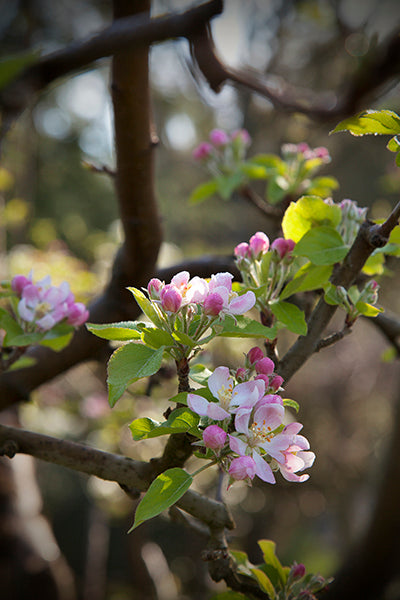
Staking may be necessary but should be done carefully. A young tree that struggles a little against the wind, without being blown over, develops tissue in its trunk that will strengthen the tree as it matures. Tightly staked trees that do not develop this tissue are at greater risk of wind damage as they grow older. Staking should provide emergency assistance to a young tree, but should not interfere with its natural capacity to resist wind. To properly stake your tree, drive two sturdy poles deeply into the ground on opposite sides of the tree from each other. The two poles and the tree should demarcate a straight line directly into the prevailing wind. Using a plastic tie or cord attached securely to each pole, create a loose harness that will allow the tree sufficient movement in the wind at least a few inches in all directions.
Over-watering can kill young trees. Moist, workable soil is sufficient; soggy soil is dangerous and often fatal. As the tree matures, you will want to water deeply but infrequently. Contact your local Master Gardeners or Agricultural Advisor for watering recommendations for your area. As your tree matures, pruning will become the most critical factor in its proper growth and development.
Spraying fruit trees during the dormant season is an important preventative to many diseases and pest problems. Traditionally fruit trees are sprayed three times a year: at leaf drop (Thanksgiving), during full dormancy (New Year’s) and at bud swell (Valentine’s Day). Check out our pest control page for more information and a selection of natural and organic dormant sprays.
Disease Prevention
There are many organic fungicides, insecticides and miticides available to control pests on fruit trees, nut crops, citrus, vegetables, and ornamentals. Download our Pest Control Solution Chart to find helpful information on specific disease and pests.
Tips For Planting Finicky Trees
Almonds are subject to desiccation, especially the buds, and should be protected from the wind and drying out. Use 50/50 mix of water and white latex paint and paint the tree to protect it from heat and sun damage.
When planting persimmons it is important to remember that persimmons are not water loving plants. After the tree is planted, it should be watered in with a good soaking to remove air pockets in the soil and then left alone. The plant shouldn’t be watered again until the buds start to break. Excessive watering is the primary cause of failure in bare root persimmons.
Mulberries are prone to desiccation and frost damage when planted from bare root. To reduce the risk of plant loss, it is a good idea to thoroughly hydrate the plant and prune back the lateral growth of the plant to reduce the amount of surface area exposure.
To increase survival rate of multi-grafts it is important not to let one graft overtake the tree. If the different fruit varieties (the limbs) are not well-spread on your trees, use a spreader to separate them. Always plant the smallest limb (the “weakest” bud) to the south or southwest to insure that it gets plenty of sun. Prune back the strongest growing varieties by two thirds. Prune back the weakest variety by half or not at all. During the summer, watch the growth-rate of the smaller limbs to determine if pruning is necessary at that time. If the weakest variety is half the size of the others, it’s best not to cut it back. Prune back the more aggressive limbs. Summer-prune when necessary in order to let sunlight get to all the developing varieties. Keep even sunlight available to all the developing selections. After the third season, maintain the multi-budded tree so that each fruit-type grows in balance with the others.


